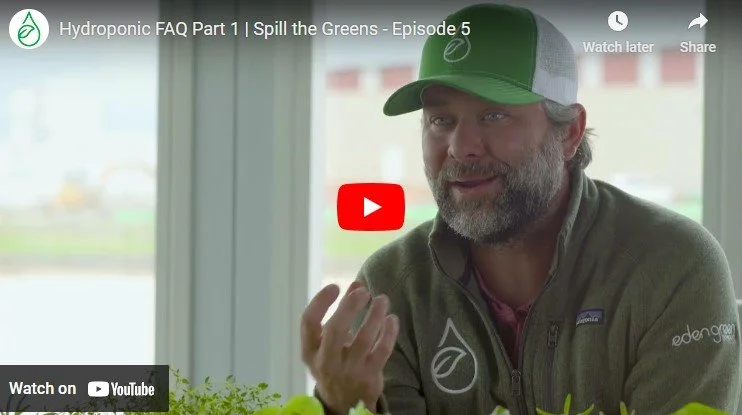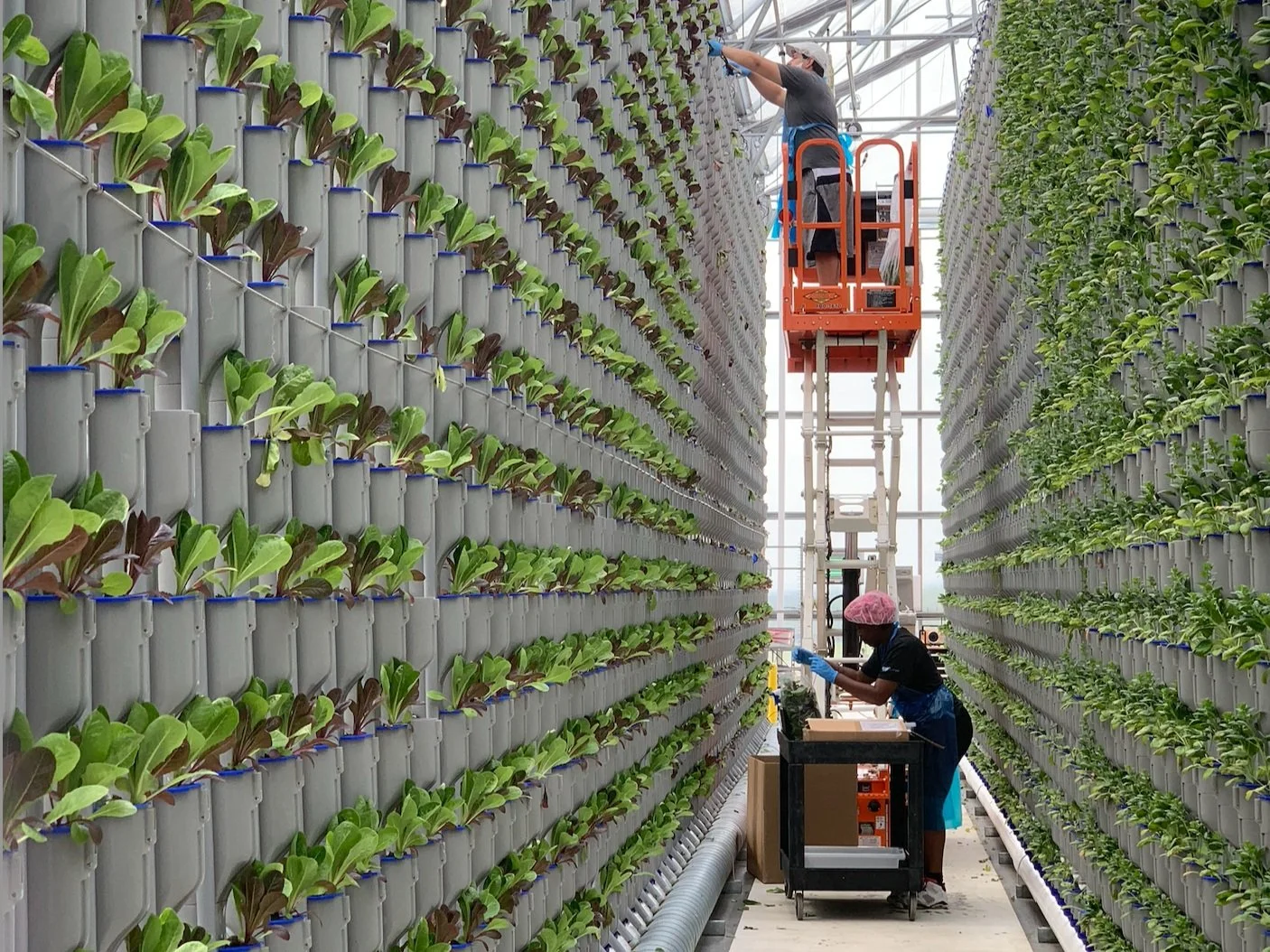CEA Glossary of Terms
Absolute Humidity
Absolute humidity measures the actual amount of water vapor in the air. It's typically expressed in grams per cubic meter. This measurement is critical for managing greenhouse environments. It's crucial for ensuring optimal humidity for plant growth.
Acidity
Acidity refers to the pH level of a solution, indicating how acidic or alkaline it is. Proper pH balance is vital for nutrient uptake in hydroponic systems.
Aeroponics
Aeroponics is a soilless growing method for agriculture. In this system, plants are nourished by misting roots with nutrient-rich water. This technology can enhance aeration and nutrient absorption, reducing water use. For more details, see:
Aggregation
Aggregation refers to the way soil particles clump together. This affects water retention and root growth. In hydroponics, aggregation refers to the growing medium that supports plants in place of soil.
Agricultural Meteorology
Agricultural meteorology studies how weather and climate impact farming operations. Indoor growers may use these insights to optimize greenhouse conditions.
Aquaponics
Aquaponics combines aquaculture (raising fish) and hydroponics (growing plants in water). In this symbiotic system, fish waste provides nutrients for plants. When done carefully, this can be a sustainable, closed-loop system. For more details, see:
Aspirator Boxes
Aspirator boxes sample and analyze air quality in controlled environments. These devices are essential for maintaining the ideal air conditions in high-tech greenhouses.
Bio-Stimulants
Bio-stimulants are natural compounds that enhance plant growth. They improve nutrient efficiency and stress tolerance. They are frequently employed to boost yield and health in hydroponic crops.
Bract
Bract refers to modified leaves, often mistaken for petals, located at the base of flowers. Bracts are significant in plant identification and breeding. They are frequently used in research to develop optimal plant varieties.
Chiller
A chiller is used to cool water in hydroponic systems. This is crucial for maintaining the right root temperatures. Chillers help ensure plants grow in ideal thermal conditions.
Coco Coir
Coco coir is a sustainable, fibrous material made from coconut husks. It is often used as a growing medium in hydroponics. Many growers favor coco coir for its excellent air and water retention properties. For more details, see:
Controlled Environment Agriculture (CEA)
Controlled environment agriculture refers to farming within a controlled setting. CEA growers use technology to optimize greenhouse conditions year-round. These systems enhance efficiency and productivity through advanced climate and lighting control. For more details, see:
Cropping Cycle
A cropping cycle is the complete growing sequence from planting to harvest. CEA growers optimize cropping cycles to ensure continuous, year-round production in their greenhouses.
Cross-Pollination
Cross-pollination refers to the transfer of pollen from one plant to another. This vital process is a natural way of promoting genetic diversity. In CEA, controlled cross-pollination can develop stronger, more resilient plant varieties.
Cutting
Cutting is a method of plant propagation using sections of a plant to grow new ones. Growers may employ cuttings to clone selected plants for uniformity and quality.
Dosing
Dosing describes the precise application of nutrients in a hydroponic system. Dosing techniques help ensure each plant receives the nutrients needed for optimal growth.
Food Miles
Food miles is a term used to describe the distance food travels from production to consumer. Urban farms reduce food miles by locating greenhouses closer to urban centers. This helps ensure fresh produce delivery while burning fewer fossil fuels in transit.
Food Safety
Food safety refers to practices that prevent contamination or illnesses in the food supply. Eden Green adheres to stringent food safety standards to ensure clean, safe produce from its greenhouses. For more details, see:
Food Supply Chain Capacity and Resiliency Act
The Food Supply Chain Capacity and Resiliency Act was introduced in the US House in July of 2023. It is a legislative effort to strengthen our food supply chains.
Greenhouse Management
Greenhouse management refers to the practice of overseeing the operations of a greenhouse. CEA management strategies optimize plant health and productivity through advanced environmental controls.
Grow Lights
Grow lights are artificial lighting used to simulate sunlight and promote photosynthesis. Vertical farms often use grow lights in set-ups that have limited natural light. They can also simulate seasons with longer daylight than the current conditions outside. For more details, see:
High-Tech Greenhouse
A high-tech greenhouse features the latest technology for precision agriculture. These greenhouses can often monitor and adjust conditions automatically. This serves to maximize growth efficiency and plant health. For more details, see:
Horticulturist
A horticulturist is a specialist in garden cultivation and management. Our horticulturists drive innovation in plant growth, focusing on sustainable and efficient practices.
Hybrid Farms
Hybrid farms integrate traditional agriculture with modern technologies. A hybrid approach may combine new and old growing methods to optimize resource use and yield.
Hydroponics
Hydroponics is a method of growing plants in water rather than soil. In such a system, nutrient-enriched water feeds plant roots directly. This conserves water and space while increasing crop yield. For more details, see:
Indoor Farming
In indoor farming, growers cultivate plants within buildings. They typically use controlled environment agriculture techniques. The best indoor farming practices reduce resource waste, boosting sustainability. They can also allow growers to produce harvests regardless of weather or climate.
Indoor Growers
Indoor growers specialize in cultivating plants inside controlled environments. These growers often employ high-tech systems that optimize plant health and productivity.
Indoor Vertical Farms
Indoor vertical farms grow crops in stacked layers indoors to maximize space efficiency. They employ vertical farming to increase yield per square foot. This is crucial to success in urban areas. For more details, see:
Input
Input refers to resources like water, nutrients, and energy used in farming. Sustainable growers carefully manage inputs to maximize efficiency and minimize environmental impact.
Integrated Pest Management
Integrated pest management is a sustainable approach to managing agricultural pests. It seeks to minimize harm to people and the environment. Sustainable farms use this method to protect crops without excessive chemical use.
Irrigation Strategy
An irrigation strategy is a plan for watering plants efficiently. Advanced irrigation strategies are designed to use water resourcefully. They reduce waste and ensure optimal plant growth.
Leaf Temperature
Leaf temperature is the temperature of a plant’s leaves. This measurement is important for photosynthesis and transpiration rates. Eden Green monitors leaf temperature to maintain plant health and productivity.
Mechanical, Electrical, and Plumbing Systems
Mechanical, electrical, and plumbing systems (MEP systems) support the operation of indoor farms. CEA greenhouses are often equipped with advanced MEP systems. The technology allows them to maintain optimal growing environments.
Media
Media is the material in which plants are grown, such as coco coir or peat moss. Hydroponic growers select media that best works within their systems. They may also consider the best fit for each type of plant they are cultivating. For more details, see:
Nutrient Film Technique
Nutrient Film Technique (NFT) is a type of hydroponic system. In NFT, a shallow stream of water containing dissolved nutrients circulates past the roots of plants. Eden Green utilizes NFT to ensure consistent nutrient delivery and oxygenation.
Peat Moss
Peat moss is an organic material composed of decomposed plants. It is often used as a soil amendment in traditional gardens. Hydroponic growers may use peat moss as a growing medium. It retains moisture and aerates the root zone well. For more details, see:
Perlite
Perlite is a volcanic glass that is expanded for use by growers. It is a common aerator and moisture retainer in potting soils and hydroponics. Many hydroponic growers use perlite growing media to improve drainage and root growth. For more details, see:
Plant Health
Plant health refers to the overall wellness of a plant, crucial for its growth and yield. CEA prioritizes plant health through rigorous monitoring and environmental controls. Hydroponic growers do so through the application of tailored nutrients and water controls.
Plant Health Management
Plant health management strategies help prevent, diagnose, and treat plant diseases and conditions. Most indoor farms use plant health management strategies to maintain robust, disease-free crops.
Plant Performance
Plant performance refers to how well plants grow, produce, and reproduce. Most commercial growers track plant performance to optimize their operations. Performance can reveal environmental factors that improve crop quality and yield.
Plant Propagation
Plant propagation involves growing new plants from seeds, cuttings, or other parts. Indoor farming uses advanced propagation techniques to ensure healthy and uniform crop production.
Plant Science
Plant science is the study of plant growth, development, and adaptation. This research helps develop new methods for modern farming. It also increases efficiency and sustainability in hydroponic farming.
Plant Sensors
Plant sensors monitor various parameters, such as moisture, nutrients, and growth rates. CEA growers employ plant sensors to automate and refine growing environments.
Production
Production in agriculture is the process of using crops to enhance human life. It aims to meet demands for food, fuel, and fiber sustainably. Modern growers focus on production that prioritizes sustainability. They seek to optimize crop yields to support essential human needs efficiently and responsibly.
Propagation
Propagation is the act of reproducing plants by natural or artificial means. Many growers use propagation to rapidly multiply its most successful plant varieties.
Rockwool
Rockwool is a fibrous material made from molten rock. It is frequently used as a growing medium in hydroponics. Hydroponics values rockwool for its water retention and aeration properties. As a growing medium, it helps promote strong root development. For more details, see:
Rootzone
Rootzone refers to the part of the soil or growth medium that surrounds the roots of a plant. CEA growers carefully manage the rootzone environment. They optimize the conditions here to ensure optimal nutrient uptake and plant health.
Substrate Properties
Substrate properties are the characteristics of the growing medium. They include properties like water retention, aeration, and pH. Each of these factors influences plant growth.
Supporting Urban and Innovative Farming Act of 2023
The Supporting Urban and Innovative Farming Act of 2023 is a piece of federal legislation. It was introduced in July of 2023 to increase access to federal support for urban farms.
Sustainable Farming
Sustainable farming includes methods that do not deplete resources or harm the environment. Sustainable growing methods seek to ensure long-term agricultural productivity. This should include techniques that conserve water, energy, and land.
U.S. Department of Agriculture’s (USDA) Office of Urban Agriculture and Innovative Production (OUAIP)
The OUAIP is a branch of the USDA that supports and promotes urban and innovative agricultural practices. The department seeks to advance urban farming technologies and implement sustainable practices.
Vertical Farming
Vertical farming refers to growing crops in stacked layers in trays or towers. This growing method can significantly increase production per square foot. It is an efficient way to convert urban spaces to agricultural use. For more information, see:
Water Quality
Water quality is defined by chemical, physical, and biological characteristics. While this is essential to agriculture, it's even more vital in hydroponics. Growers must ensure high water quality to promote healthy plant growth.









